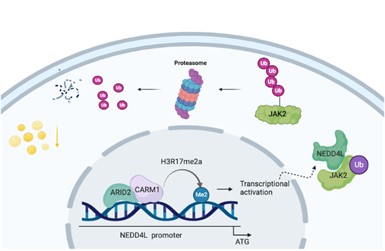A recent study led by Dr. XIE Dong’s group from Shanghai Institute of Nutrition and Health(SINH) of the Chinese Academy of Sciences(CAS), revealed the important role of ARID2 in the development of non-alcoholic fatty liver disease(NAFLD) and provided a potential therapeutic strategy for NAFLD. This work entitled “ARID2 mitigates hepatic steatosis via promoting the ubiquitination of JAK2” was published online in Cell Death & Differentiation on Nov. 17th, 2022.
Non-alcoholic fatty liver disease has become serious threats to world health. Hepatic steatosis, defined as the accumulation of triglycerides(TG) within hepatocytes, is the primary hallmark of NAFLD. Obesity and diabetes contribute to the prevalence of NAFLD worldwide, which may cause severe hepatic outcomes including NASH, hepatic cirrhosis, liver failure and hepatocellular carcinoma, thus increasing liver-related mortality. However, no effective therapy has been approved for the treatment of NAFLD because of its complicated pathogenesis. Previous studies have underscored the importance of genetic factors in the development of NAFLD. Hence, identification of the major genetic factors contributing to the development of NAFLD and clarification of their function will provide therapeutic benefit for this disease.
ARID2 is a subunit of chromatin remodeling complexes SWI/SNF, which is involved in numerous biological processes. The SWI/SNF complex remodels nucleosomes and binds to specific DNA regions to regulate gene expression by influencing epigenetic modifications.
Recently, increasing evidence has suggested that subunits of SWI/SNF show significant importance in metabolic homeostasis. For example, BAF60a was identified as a regulator of hepatic lipid metabolism. Loss of Arid1a drove NAFLD in mice via epigenetic dysregulation of hepatic genes involved in lipogenesis and fatty acid oxidation. However, the role of ARID2 in the development of NAFLD remains elusive.
In this study, researchers found that liver-specific Arid2 knockout mice developed spontaneous steatosis on chow diet and were more susceptible to HFD-induced hepatic steatosis. They explored the underlying mechanism and disclosed ARID2-mediated inhibition of JAK2-STAT5-PPARγ signaling. ARID2 promoted ubiquitination of JAK2 via upregulation of its E3 ligase NEDD4L. CARM1 was recruited by ARID2 to increase H3R17me2a level at the NEDD4L promoter. Accordingly, JAK2 inhibitor Fedratinib could restrain hepatic steatosis induced by HFD in Arid2 LKO mice. Decreased ARID2 level and the negative correlation between ARID2 and JAK2 were further confirmed in the commercially available clinical samples.
Therefore, this study elucidated the significant role of ARID2 in maintaining hepatic lipid homeostasis and provided potential therapeutic targets for NAFLD.
Dr. CAO Hui-Jun is the first author, Dr. XIE Dong and Dr. LI Jing-Jing are the corresponding authors of this publication. The study was funded by the grants from National Natural Science Foundation of China and Youth Innovation Promotion Association of CAS.

Schematic representation demonstrating the molecular mechanism of ARID2 in maintaining hepatic lipid homeostasis. (Image provided by Dr. XIE Dong's group)
Media Contact:
WANG Jin
Shanghai Institute of Nutrition and Health,
Chinese Academy of Sciences
Email: wangjin01@sinh.ac.cn
Web: http://english.sinh.cas.cn/

